Context
If you are using R’s base graphics system for your plots and if you like
customizing your plots, you may have already wondered how to custom the tick
marks of your plots! I do that quite a lot and I thought it would be worth
explaining how I do so. Let’s consider the following plot,
1
2
3
|
cx <- seq(0, 2, 0.1)
cy <- cx + .5 * rnorm(length(cx))
plot(cx, cy)
|
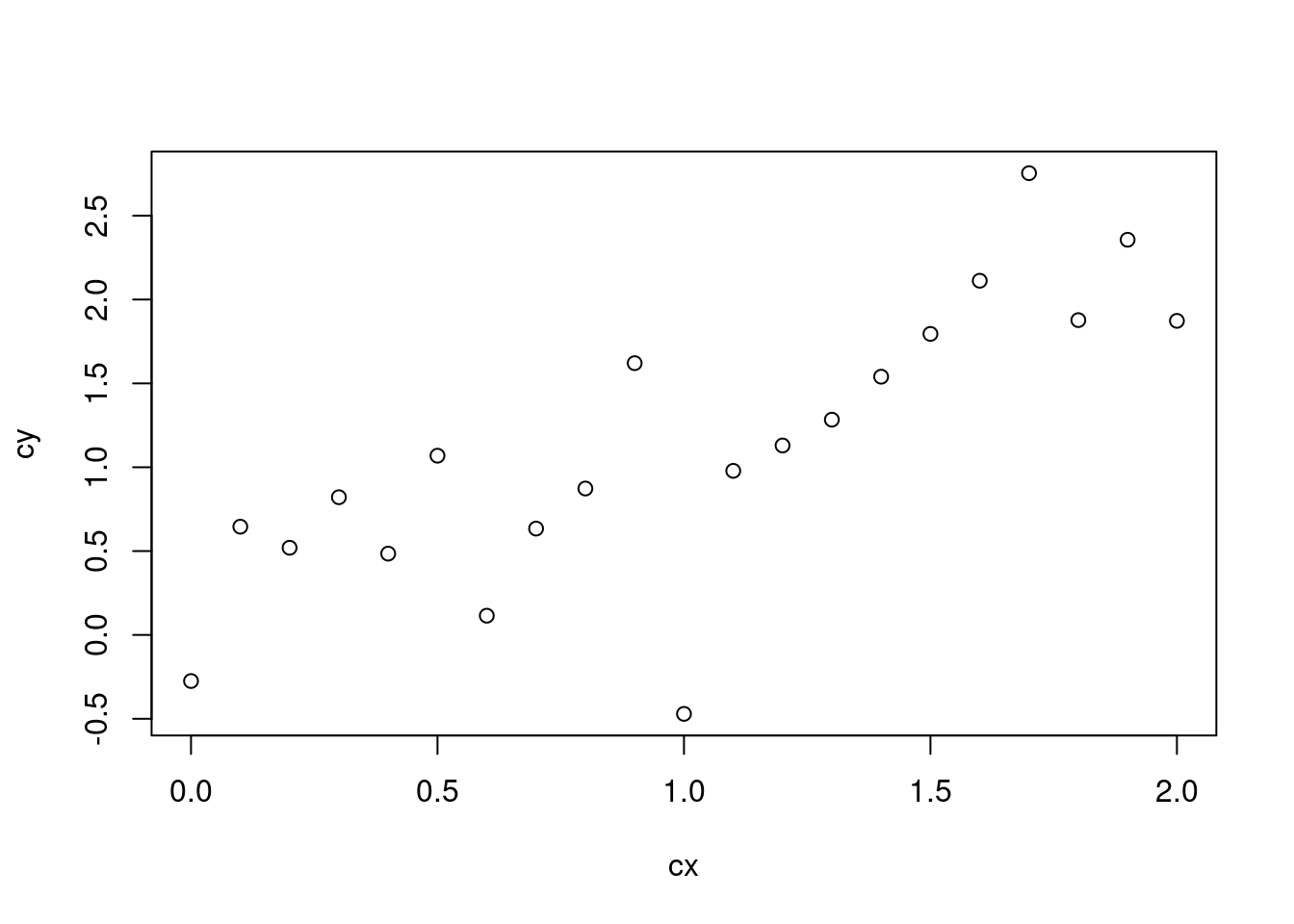
By default, plot.default internally has its way to decide where tick marks
should be added. It is always a good default choice, but sometimes not the one
you’re looking for. Fortunately, the core package graphics includes all what
you need to custom the tick marks and so, without further ado, let’s custom our
ticks!
Remove axes and add them back
The first step is to remove all axes. There are basically two ways. One option
is to use xaxt = "n" and yaxt = "n" to selectively remove the x-axis and
the y-axis, respectively.
1
|
plot(cx, cy, xaxt = "n")
|

1
|
plot(cx, cy, xaxt = "n", yaxt = "n")
|

The second option is to set axes to FALSE in plot():
1
|
plot(cx, cy, axes = FALSE)
|

As you can see, when axes = FALSE the box is also removed and you can actually add it back with box():
1
2
|
plot(cx, cy, axes = FALSE)
box()
|

and change its style, if desired:
1
2
|
plot(cx, cy, axes = FALSE)
box(bty = "l")
|

That being said, let’s only remove the x-axis for the moment and add ticks at 0,
0.5, 1, 1.5 and 2 to the x-axis using axis():
1
2
|
plot(cx, cy, xaxt = "n")
axis(1, at = seq(0, 2, .5))
|

I can easily change the labels if values on the axis are not the ones that
should be displayed, e.g.
1
2
|
plot(cx, cy, xaxt = "n")
axis(1, at = seq(0, 2, .5), labels = letters[1:5])
|

Second set of tick marks
Now, let’s add a second set tick marks! This can be done by calling axis() one
more time.
1
2
3
|
plot(cx, cy, xaxt = "n")
axis(1, at = seq(0, 2, .5))
axis(1, at = setdiff(cx, seq(0, 2, .5)), labels = NA)
|

As you may have noticed, I use setdiff() to select the complementary set of
ticks. I think it is an efficient of proceeding: I first select the finest gap
between two ticks (here 0.1) and create the sequence with seq(), then create
the main set of tick marks and finally use setdiff() will to add the
remaining tick marks. Also here, as I don’t want to add extra labels, I just set
the labels to NA.
The main reason why I adjust the tick marks on my plots is because axis() and
box() add lines that partially overlap (this is also true when you use the
default behavior of plot()): the lines that comes along with the ticks
1
2
3
4
|
plot(cx, cy, axes = FALSE)
axis(2)
axis(1, at = seq(0, 2, .5), labels = seq(0, 2, .5))
axis(1, at = setdiff(cx, seq(0, 2, .5)), labels = NA)
|

overlap with the box
1
2
|
plot(cx, cy, axes = FALSE)
box()
|

This may frequently goes unnoticed, but I personally tend to notice such overlap
this and it annoys me… Anyway, one way to handle this is to set the line width
to 0 in axis().
1
2
3
|
plot(cx, cy, xaxt = "n")
axis(1, at = seq(0, 2, .5), labels = seq(0, 2, .5), lwd = 0)
axis(1, at = setdiff(cx, seq(0, 2, .5)), labels = NA, lwd = 0)
|

and then to set the line with of the ticks, controlled by lwd.ticks, to
something greater than 0
1
2
3
4
|
plot(cx, cy, xaxt = "n")
axis(1, at = seq(0, 2, .5), labels = seq(0, 2, .5), lwd = 0, lwd.ticks = 1)
axis(1, at = setdiff(cx, seq(0, 2, .5)), labels = NA, lwd = NA, lwd.ticks = 1)
box()
|

Note that if you only wish to remove the marks you can use tick = FALSE.
1
2
3
4
|
plot(cx, cy, xaxt = "n")
axis(1, at = seq(0, 2, .5), labels = seq(0, 2, .5), tick = FALSE)
axis(1, at = setdiff(cx, seq(0, 2, .5)), labels = NA, tick = FALSE)
box()
|

But if you just want to get rid of the extra line, but not the ticks, then you
need set lwd to 0 and lwd.ticks to a positive values.
Custom the ticks
Having done the steps above, you may have realized that fine-tuning lwd.ticks
is a good way to custom your tick marks!
1
2
3
4
|
plot(cx, cy, xaxt = "n")
axis(1, at = seq(0, 2, .5), labels = seq(0, 2, .5), lwd = 0, lwd.ticks = 1.5)
axis(1, at = setdiff(cx, seq(0, 2, .5)), labels = NA, lwd = 0, lwd.ticks = .5)
box()
|

A second parameter to further customize the tick marks is tck that actually
belongs to par()
1
2
3
4
5
6
7
8
|
par(tck = -0.07)
plot(cx, cy, xaxt = "n")
axis(1,
at = seq(0, 2, .5), labels = seq(0, 2, .5), lwd = 0,
lwd.ticks = 1
)
axis(1, at = setdiff(cx, seq(0, 2, .5)), labels = NA, lwd.ticks = 1)
box()
|
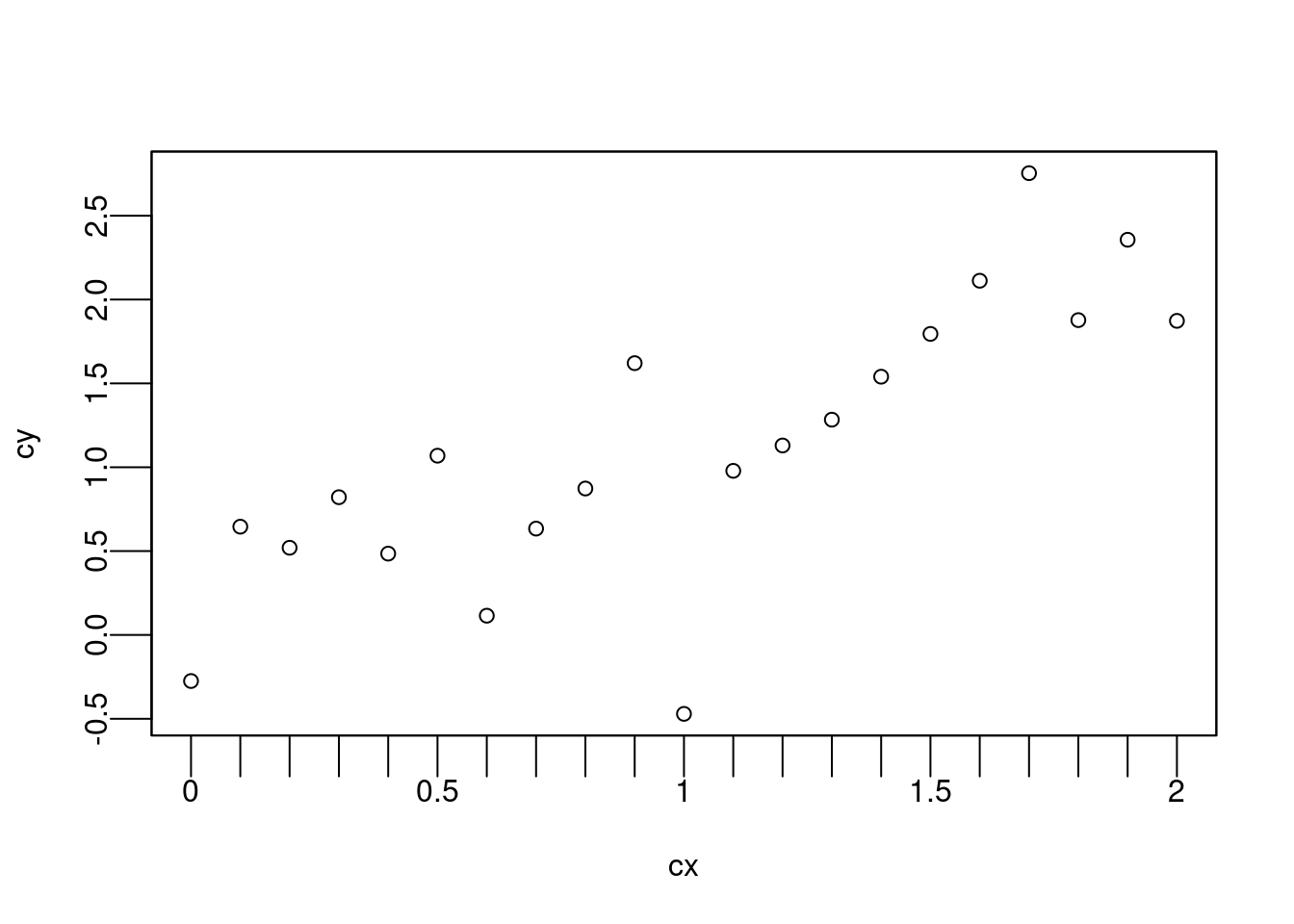
but can also be used with axis() thanks to the ellipsis (...) which allow me
to change it only for one set of ticks
1
2
3
4
5
6
7
|
plot(cx, cy, xaxt = "n")
axis(1,
at = seq(0, 2, .5), labels = seq(0, 2, .5), lwd = 0, tck = -0.07,
lwd.ticks = 1
)
axis(1, at = setdiff(cx, seq(0, 2, .5)), labels = NA, lwd.ticks = 1)
box()
|
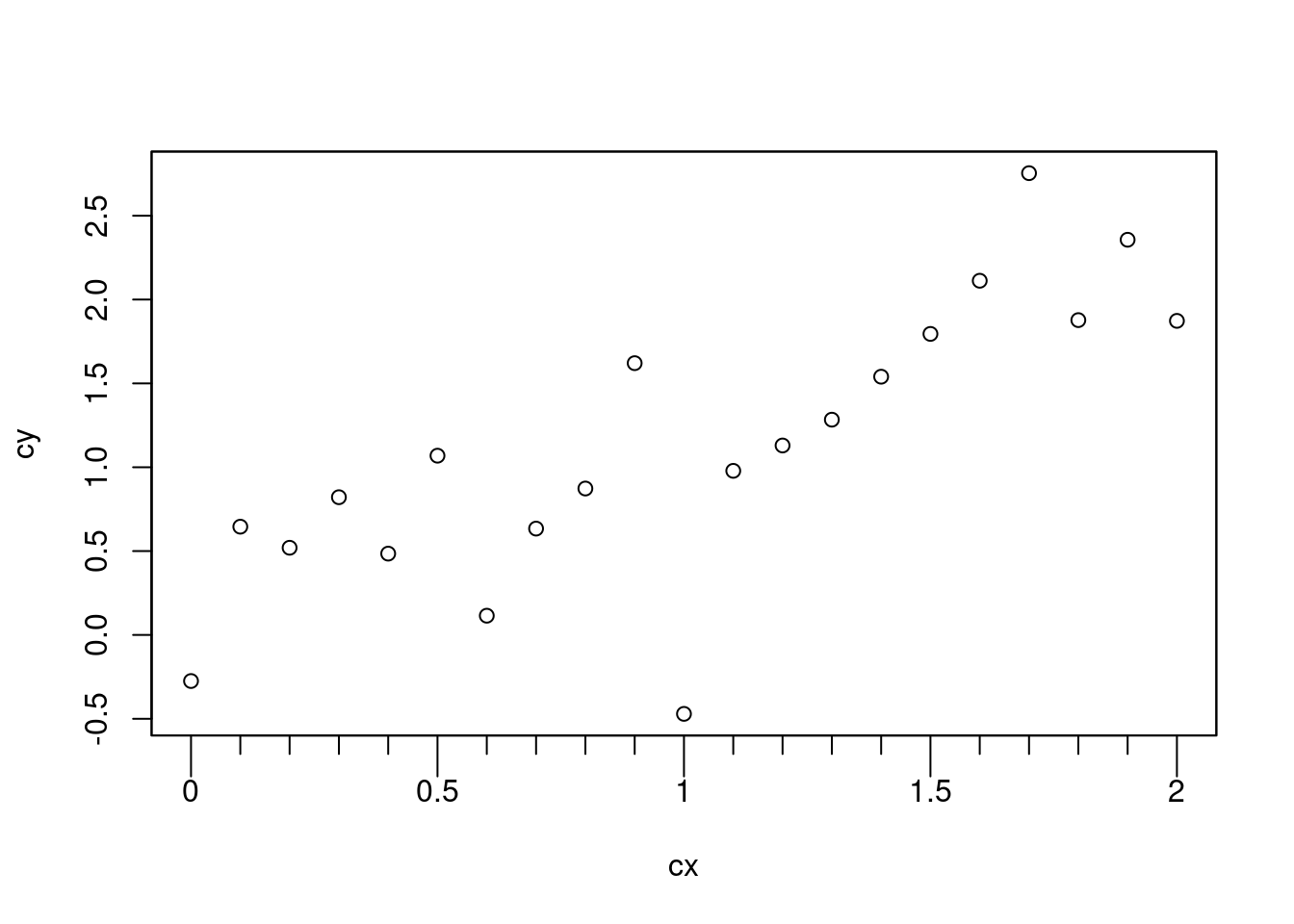
Moreover, using positive value you can make the tick go up!
1
2
3
4
5
6
7
|
plot(cx, cy, xaxt = "n")
axis(1,
at = seq(0, 2, .5), labels = seq(0, 2, .5), lwd = 0, tck = 0.07,
lwd.ticks = 1
)
axis(1, at = setdiff(cx, seq(0, 2, .5)), labels = NA, lwd.ticks = 1)
box()
|

And finally you change many aspect of them, including color then and line type:
1
2
3
4
|
plot(cx, cy, xaxt = "n")
axis(1, at = seq(0, 2, .5), labels = seq(0, 2, .5), lwd = 0, lwd.ticks = 1.5, tck = -.07, col = 2, lty = 2)
axis(1, at = setdiff(cx, seq(0, 2, .5)), labels = NA, lwd.ticks = .5, tck = -.03, col = 3)
box()
|

One more tip, if you need to adjust the position of the tick you would have to
use mgp (also documented in par) which is a vector of three elements
controlling the following features:
- the position of the axis labels,
- the position of the tick labels,
- the positon on the tick marks.
1
2
3
4
5
6
7
8
|
par(mgp = c(2.5, 1.6, 0))
plot(cx, cy, xaxt = "n")
axis(1,
at = seq(0, 2, .5), labels = seq(0, 2, .5), lwd = 0, lwd.ticks = 1.5,
tck = -.1, col = 2, lty = 2
)
axis(1, at = setdiff(cx, seq(0, 2, .5)), labels = NA, lwd.ticks = .5, tck = -.03, col = 3)
box()
|
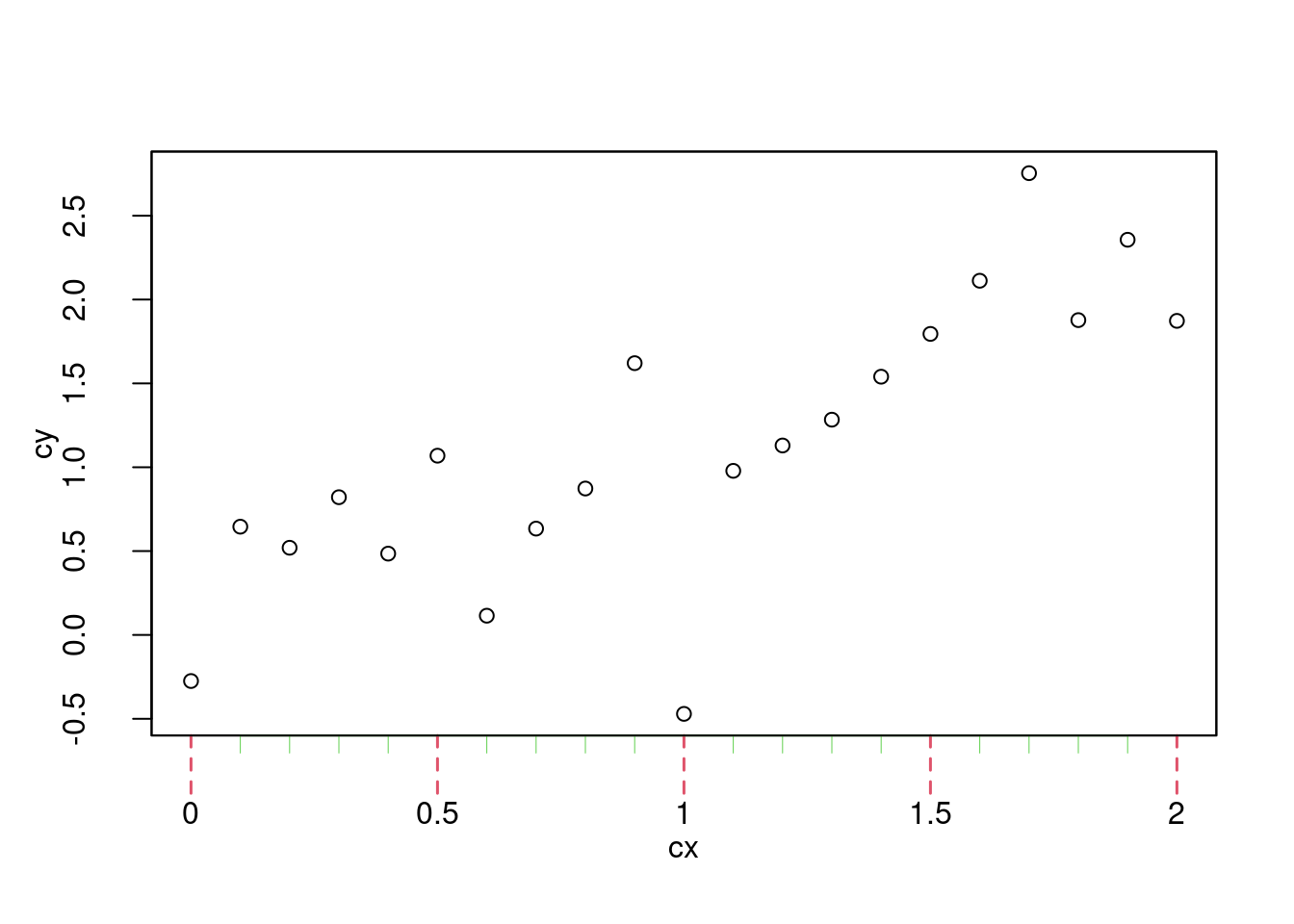
Note that, just as for tck, I can use mgp in axis(). In this example, it
won’t affected the axis labels because they were added by plot().
1
2
3
4
5
6
7
|
plot(cx, cy, xaxt = "n")
axis(1,
at = seq(0, 2, .5), labels = seq(0, 2, .5), lwd = 0, lwd.ticks = 1.5,
tck = -.1, col = 2, lty = 2
)
axis(1, at = setdiff(cx, seq(0, 2, .5)), labels = NA, lwd.ticks = .5, tck = -.03, col = 3, mgp = c(2.5, 1.6, 0))
box()
|
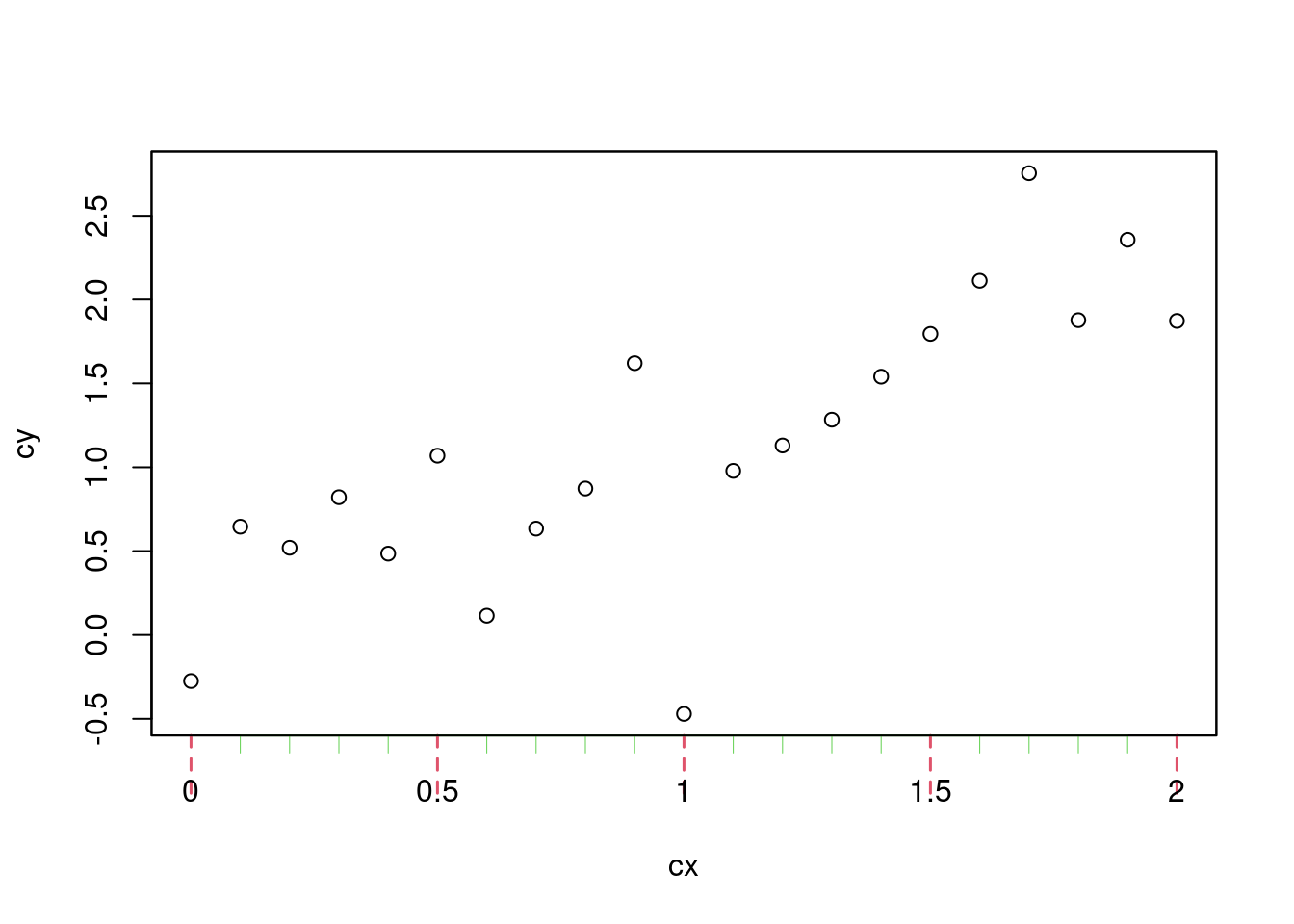
Wrap all that up in a function
All the steps above may appear overwhelming at first because you need to
memorize where is what… But once everything gets clear, you would realize that
for most of your plots you need to tweak the same parameters and so that you can
create your own function that would cover your needs. For instance, I often use
a function similar to the one below:
1
2
3
4
5
6
7
|
myaxis <- function(side, all, main, lab = main, col1 = 1, col2 = 1, ...) {
axis(side, at = main, labels = lab, lwd = 0, lwd.ticks = 1, col = col1, ...)
axis(side,
at = setdiff(all, main), labels = NA, lwd.ticks = .75, tck = -.025,
col = col2, ...
)
}
|
which basically makes the customization of tick marks very easy!
1
2
3
|
plot(cx, cy, xaxt = "n", yaxt = "n")
myaxis(1, cx, seq(0, 2, .5))
myaxis(2, seq(-0.5, 2.8, .1), seq(-0.5, 2.5, .5), las = 1)
|

That’s all folks 😄!
Display information relative to the R session used to render this post.
1
2
3
4
5
6
7
8
9
10
11
12
13
14
15
16
17
18
19
20
21
22
23
24
25
26
27
28
29
30
31
32
33
34
35
|
sessionInfo()
#R> R version 4.5.1 (2025-06-13)
#R> Platform: x86_64-pc-linux-gnu
#R> Running under: Ubuntu 24.04.2 LTS
#R>
#R> Matrix products: default
#R> BLAS: /usr/lib/x86_64-linux-gnu/openblas-pthread/libblas.so.3
#R> LAPACK: /usr/lib/x86_64-linux-gnu/openblas-pthread/libopenblasp-r0.3.26.so; LAPACK version 3.12.0
#R>
#R> locale:
#R> [1] LC_CTYPE=C.UTF-8 LC_NUMERIC=C LC_TIME=C.UTF-8 LC_COLLATE=C.UTF-8
#R> [5] LC_MONETARY=C.UTF-8 LC_MESSAGES=C.UTF-8 LC_PAPER=C.UTF-8 LC_NAME=C
#R> [9] LC_ADDRESS=C LC_TELEPHONE=C LC_MEASUREMENT=C.UTF-8 LC_IDENTIFICATION=C
#R>
#R> time zone: UTC
#R> tzcode source: system (glibc)
#R>
#R> attached base packages:
#R> [1] stats graphics grDevices utils datasets methods base
#R>
#R> other attached packages:
#R> [1] inSilecoRef_0.1.1
#R>
#R> loaded via a namespace (and not attached):
#R> [1] sass_0.4.10 generics_0.1.4 xml2_1.3.8 blogdown_1.21 stringi_1.8.7
#R> [6] httpcode_0.3.0 digest_0.6.37 magrittr_2.0.3 evaluate_1.0.4 bookdown_0.43
#R> [11] fastmap_1.2.0 plyr_1.8.9 jsonlite_2.0.0 backports_1.5.0 crul_1.5.0
#R> [16] promises_1.3.3 bibtex_0.5.1 jquerylib_0.1.4 cli_3.6.5 shiny_1.11.1
#R> [21] rlang_1.1.6 cachem_1.1.0 yaml_2.3.10 tools_4.5.1 dplyr_1.1.4
#R> [26] httpuv_1.6.16 DT_0.33 rcrossref_1.2.0 curl_6.4.0 vctrs_0.6.5
#R> [31] R6_2.6.1 mime_0.13 lifecycle_1.0.4 stringr_1.5.1 fs_1.6.6
#R> [36] htmlwidgets_1.6.4 miniUI_0.1.2 pkgconfig_2.0.3 pillar_1.11.0 bslib_0.9.0
#R> [41] later_1.4.2 glue_1.8.0 Rcpp_1.1.0 xfun_0.52 tibble_3.3.0
#R> [46] tidyselect_1.2.1 knitr_1.50 xtable_1.8-4 htmltools_0.5.8.1 rmarkdown_2.29
#R> [51] compiler_4.5.1
|



























